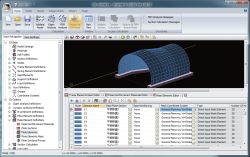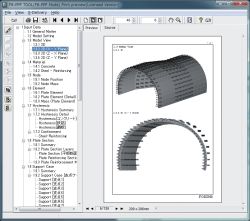| Item |
Content |
| Analysis |
- Static analysis
- Dynamic analysis
- Eigenvalue analysis
- Influence line analysis (a bar)
|
| Non-linear Analysis |
- Material non-linear
- Geometric non-linear (large displacement theory)
- Multiple non-linear (Considering material non-linear and geometric non-linear
at the same time)
|
| Application Theory |
- Small displacement theory
- Large displacement theory
- Beam theory of elastic foundation
- Beam theory of Bernoulli-Euler
- Timoshenko beam theory (Considering shear deformation)
- Reissner-Mindlin theory
|
| Element |
- Elastic beam element
- Rigid body element
- Spring element
- M-φ element
- Fiber element
- Plate element (laminated plate)
|
| Boundary Condition |
- Constrained condition of six-degree-of-freedom to nodes (free, fixed, spring)
- Distributed spring to elastic beam element (in a direction of member axis,
in right 2 directions of member axis)
- Coupled spring (defined to nodes)
|
| Type of material |
- Concrete
- Reinforcement
- PC steel (line, steel bar)
- Steel plate
- Carbon fiber sheet
- Aramid fiber sheet
- Elastic material (Input Young's modulus arbitrarily)
- Non-structural member (Material considering only unit weight)
|
| Definable load |
To the frame element:
- Node load
- Member load (concentrated, distributed, length of projection)
- Temperature loads
- Enforced displacement
To the plate element:
- Plate volume force (equivalent of self-weight)
- Plate load (distributed load)
|
| Load generated automatically |
- Dead-load
- Prestress load
- Horizontal seismic coefficient load
|
| Static Load |
- Monotone increasing
- Repeated(constant, increasing)
- Inversion repetition (constant, increasing)
|
| Dynamic Analysis |
- Direct integration method by Newmark-βmethod (β=1/4)
|
| Damping |
- Rigidity proportional type by element (Initial rigidity, instantaneous rigidity)
- Rayleigh type (Initial rigidity, instantaneous rigidity)
- Rayleigh type by element (Initial rigidity、instantaneous rigidity)
|
| Mass Matrix |
- Consistent mass matrix
- Lumped mass matrix
|
| Characteristic of non-linear |
- M-φ characteristic
- Spring characteristic
- Stress strain curve line for fiber element
|
| Fiber Element |
- Fiber element (Spring model at the ends of material)
- Fiber element (shape function primary)
- Fiber element (shape function secondary)
|
| Design Support |
- Damage display of fiber element
- Damage display of M-φelement
- Damage display of spring element
- Stress calculation (Mainly SRB)
- Strength calculation (Mainly SRB)
|





